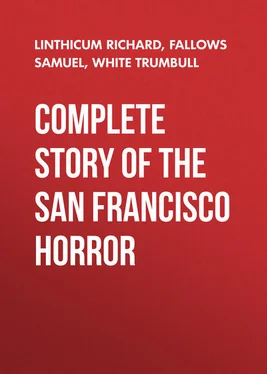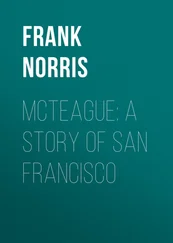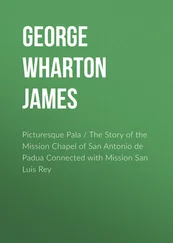Trumbull White - Complete Story of the San Francisco Horror
Здесь есть возможность читать онлайн «Trumbull White - Complete Story of the San Francisco Horror» — ознакомительный отрывок электронной книги совершенно бесплатно, а после прочтения отрывка купить полную версию. В некоторых случаях можно слушать аудио, скачать через торрент в формате fb2 и присутствует краткое содержание. Жанр: geography_book, foreign_antique, foreign_prose, на английском языке. Описание произведения, (предисловие) а так же отзывы посетителей доступны на портале библиотеки ЛибКат.
- Название:Complete Story of the San Francisco Horror
- Автор:
- Жанр:
- Год:неизвестен
- ISBN:нет данных
- Рейтинг книги:4 / 5. Голосов: 1
-
Избранное:Добавить в избранное
- Отзывы:
-
Ваша оценка:
- 80
- 1
- 2
- 3
- 4
- 5
Complete Story of the San Francisco Horror: краткое содержание, описание и аннотация
Предлагаем к чтению аннотацию, описание, краткое содержание или предисловие (зависит от того, что написал сам автор книги «Complete Story of the San Francisco Horror»). Если вы не нашли необходимую информацию о книге — напишите в комментариях, мы постараемся отыскать её.
Complete Story of the San Francisco Horror — читать онлайн ознакомительный отрывок
Ниже представлен текст книги, разбитый по страницам. Система сохранения места последней прочитанной страницы, позволяет с удобством читать онлайн бесплатно книгу «Complete Story of the San Francisco Horror», без необходимости каждый раз заново искать на чём Вы остановились. Поставьте закладку, и сможете в любой момент перейти на страницу, на которой закончили чтение.
Интервал:
Закладка:
The commercial life of San Francisco dates from 1835, when William A. Richardson, an Englishman, who had been living in Sausalito since 1822, moved to San Francisco. He erected a tent and began the collection of hides and tallow, by the use of two 30-ton schooners leased from the missions, and which plied between San Jose and San Francisco. At that time Mr. Richardson was also captain of the port.
Seventy-five years ago the white adult males, apart from the Mission colony, consisted of sixteen persons. The local census of 1852 showed a population of 36,000, and ten years later 90,000. The last general census of 1900 credits the city with a population of 343,000. The increase in the last six years has been much greater than for the previous five, and it is generally conceded that the population at the time of the fire was about 425,000.
California was declared American territory by Commodore Sleat, at Monterey, on the 7th of July, 1846, who on that day caused the American flag to be raised in that town. On the following day, under instructions from the commodore, Captain Montgomery, of the war sloop Portsmouth, performed a similar service in Yerba Buena, by which name the city afterwards christened San Francisco was then known. This ceremony took place on the plot of ground, afterward set apart as Portsmouth Square, on the west line of Kearney street, between Clay and Washington. At that time and for some years afterwards, the waters of the bay at high tide, came within a block of the spot where this service occurred. This was a great event in the history of the United States, and it has grown in importance and in appreciative remembrance from that day to the present, as the accumulative evidence abundantly shows.
Referring to the change in name from Yerba Buena to San Francisco, in 1847, a writer says: “A site so desirable for a city, formed by nature for a great destiny on one of the finest bays in the world, looking out upon the greatest, the richest, and the most pacific of oceans – in the very track of empire – in the healthiest of latitudes – such a site could not fail to attract the attention of the expanding Saxon race. Commerce hastened it, the discovery of gold consummated it.”
Modern San Francisco had its birth following the gold discoveries which led to the construction of the Central Pacific railway, and produced a vast number of very wealthy men known by the general title of California Bonanza Kings. San Francisco became the home and headquarters of these multi-millionaires, and large sums of their immense fortunes were invested in palatial residences and business blocks.
The bonanza king residence section was Nob Hill, an eminence near the business part of the city.
In the early days of San Francisco’s growth and soon after the Central Pacific railroad had been built by Leland Stanford, Charles Crocker, Mark Hopkins, Collis P. Huntington and the others who devoted the best part of their lives to the project of crossing the mountains by rail this hill was selected as the most desirable spot in the city for the erection of homes for the use of wealthy pioneers.
The eminence is situated northwest of the business section of the city and commands a view of the bay and all adjacent territory with the exception of the Pacific Ocean, Russian Hill, Pacific Heights and several other high spots obscuring the view toward the west.
Far removed above the din and noise of the city Charles Crocker was the first to erect his residence on the top of this historic hill which afterward became known as Nob Hill. The Crocker home was built of brick and wood originally, but in later years granite staircases, pillars and copings were substituted. In its time it was looked upon as the most imposing edifice in the city and for that reason the business associates of the railroad magnate decided to vie with him in the building of their homes.
Directly across from the Crocker residence on California street Leland Stanford caused to be built a residence structure that was intended to be the most ornate in the western metropolis. It was a veritable palace and it was within its walls that the boyhood days of Leland Stanford, Jr., after whom the university is named, were spent in luxurious surroundings. After the death of the younger Stanford a memorial room was set apart and the parents permitted no one to enter this except a trusted man servant who had been in the family for many years.
But the Stanford residence was relegated to the background as an object of architectural beauty when Mark Hopkins invaded the sacred precincts of Nob Hill and erected the residence which he occupied for three or four years. At his death the palatial building was deeded to the California Art Institute and as a tribute to the memory of the sturdy pioneer the building was called the Hopkins Institute of Art. Its spacious rooms were laden with the choicest works of art on the Pacific coast and the building and its contents were at all times a source of interest to the thousands of tourists who visited the city.
The late Collis P. Huntington was the next of the millionaires of San Francisco to locate upon the crest of Nob Hill. Within a block of the Crocker, Stanford and Hopkins palaces this railroad magnate of the west erected a mansion of granite and marble that caused all the others to be thrown in the shade. Its exterior was severe in its simplicity, but to those who were fortunate to gain entrance to the interior the sight was one never to be forgotten. The palaces of Europe could not excel it and for several years Huntington and his wife were its only occupants aside from the army of servants required to keep the house and grounds in order.
Not to be outdone by the railroad magnates of the city the next to acquire property on the crest of the hill was James Flood, the “bonanza king” and partner with William O’Brien, the names of both being closely interwoven with the early history of California and the Comstock lode. After having paid a visit to the east the millionaire mine owner became impressed with the brown stone fronts of New York and outdone his neighbors by erecting the only brown stone structure in San Francisco.
It was in this historic hilltop also that James G. Fair laid the foundation of a residence that was intended to surpass anything in the sacred precincts, but before the foundations had been completed domestic troubles resulted in putting a stop to building operations and it is on this site that Mrs. Hermann Oelrichs, daughter of the late millionaire mine owner, erected the palatial Fairmont hotel, which was one of the most imposing edifices in San Francisco.
The old San Francisco is dead. The gayest, lightest hearted, most pleasure loving city of this continent, and in many ways the most interesting and romantic, is a horde of huddled refugees living among ruins. But those who have known that peculiar city by the Golden Gate and have caught its flavor of the Arabian Nights feel that it can never be the same. It is as though a pretty, frivolous woman had passed through a great tragedy. She survives, but she is sobered and different. When it rises out of the ashes it will be a modern city, much like other cities and without its old flavor.
The city lay on a series of hills and the lowlands between. These hills are really the end of the Coast Range of mountains which lie between the interior valleys and the ocean to the south. To its rear was the ocean; but the greater part of the town fronted on two sides on San Francisco Bay, a body of water always tinged with gold from the great washings of the mountains, usually overhung with a haze, and of magnificent color changes. Across the bay to the north lies Mount Tamalpais, about 5,000 feet high, and so close that ferries from the water front took one in less than half an hour to the little towns of Sausalito and Belvidere, at its foot.
Читать дальшеИнтервал:
Закладка:
Похожие книги на «Complete Story of the San Francisco Horror»
Представляем Вашему вниманию похожие книги на «Complete Story of the San Francisco Horror» списком для выбора. Мы отобрали схожую по названию и смыслу литературу в надежде предоставить читателям больше вариантов отыскать новые, интересные, ещё непрочитанные произведения.
Обсуждение, отзывы о книге «Complete Story of the San Francisco Horror» и просто собственные мнения читателей. Оставьте ваши комментарии, напишите, что Вы думаете о произведении, его смысле или главных героях. Укажите что конкретно понравилось, а что нет, и почему Вы так считаете.












